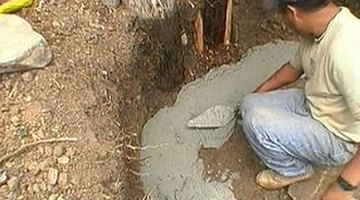How to Make a Stone Bench
Building a stone bench on your property can add beauty, comfort and lasting value to your outdoor space. Because of the weight of the stones and the time required to cut and mortar them, this is a physically demanding project that is best undertaken with assistance. Once completed, your bench will be an attractive and sturdy addition that is certain to be a focal point for future entertaining. Allow yourself a minimum of three full days to complete this project after assembling your materials and preparing your work site.

Step 1

Put on your work gloves and goggles. Remove shrubs, gravel and any other obstructions from the area you have designated for your stone bench using your shovel and pickax. If the area is on an incline, start by cutting out a curvilinear arc into the slope, creating a low retaining wall that is vertically straight to mark the back of the bench. Once the ground is cleared, sweep the area smooth.
Step 2

Carve an outline of the shape of your bench on the ground in the cleared soil with either the end of the pickax or a pointed stick. Dig this area out with your shovel to a depth of 1 1/2 feet to support the base of the bench.
Step 3

Soak the ground thoroughly with water from a garden hose to avoid problems caused by the soil absorbing moisture from the mortar. Prepare and spread a two-inch layer of mortar within the boundaries of your bench's outline. Maintain a gap for the later placement of stones for the back of the bench as you place two adjacent rows of river rocks into the mortar. Tap them into place with a mallet, and apply a layer of mortar on top of the rocks.
Step 4

Lay two more adjacent rows of river rock on top of the first course of stones, staggering the seams with the layer below them. Use a plumb line to ensure that the front edge of each layer of rocks is vertically straight. Apply more mortar, and continue until you have about five layers of mortared stone reaching 1.5 feet high. For the top layer, place stones and mortar only in the front row, maintaining a space in back for holding the materials that will make up the backrest. Wipe away any extra mortar from the rocks with damp sponges, and allow the base to cure overnight.
Step 5

Place several large flagstone slabs vertically upright in the space behind the base of your bench. They should extend about 2 feet above the base of the bench for optimal comfort. Draw lines on their sides with a pencil to show where they need to be cut to fit roughly together.
Step 6

Cut away the excess stone with an angle grinder and bevel the cut edges with a chisel for a naturally hewn look. Smaller stone fragments can be used for filling in the gaps later. Mortar the flagstones into place, fitting the cut edges together and curving them against the base of the bench. Mortar the smaller fragments in front of and behind the backrest for additional support.
Step 7

Place smaller flagstone segments (about one-fourth the size of the stones used for the backrest) on top of the base to form the seat. Arrange them against the backrest, covering the base like puzzle pieces. Check that your work is level as you proceed. Cut or bevel the outer edges of the seat to eliminate uneven overhanging. Once you are satisfied with the look of the seat, mortar the flagstones into place. Fill in any gaps with smaller stones pressed into the mortar. Allow your finished stone bench to cure at least 24 hours before use.
Tips
- Anyone assisting you should also be wearing protective gear for safety reasons.
Warnings
- Use caution when cutting flagstone as tiny fragments can break off and cause injury.
Writer Bio
Genae Valecia Hinesman, former banking executive, entrepreneur and fashion model, began writing professionally in 2002. She is a Cum Laude graduate of the University of Southern California where she studied business, finance and exercise physiology. Her articles featured in Living Healthy: 360, Life 123, the American Chronicle and Yahoo Voices.
Photo Credits
- HGTV
More Articles



